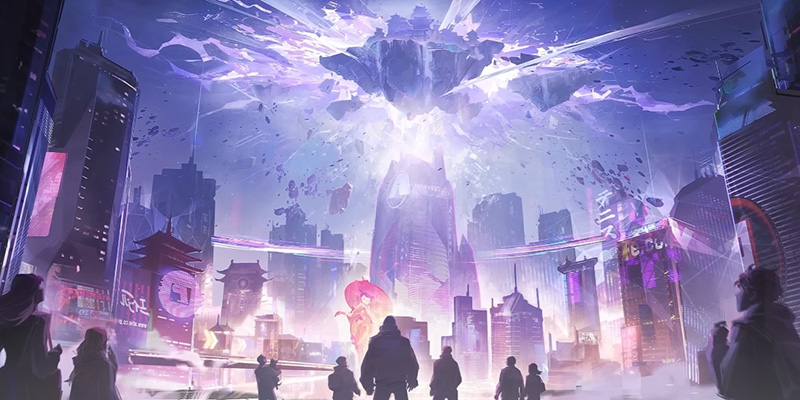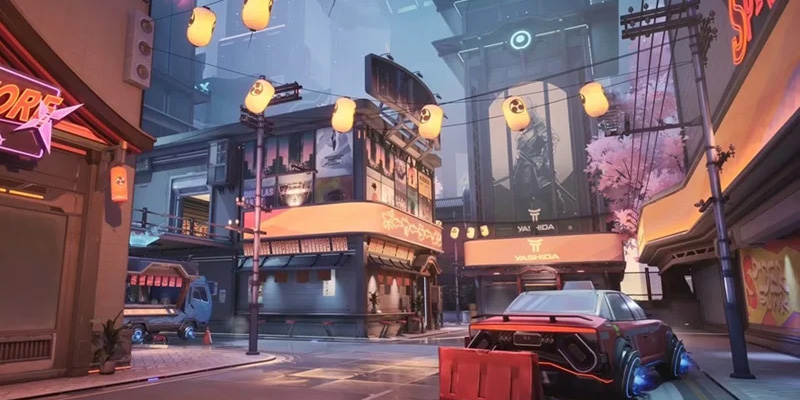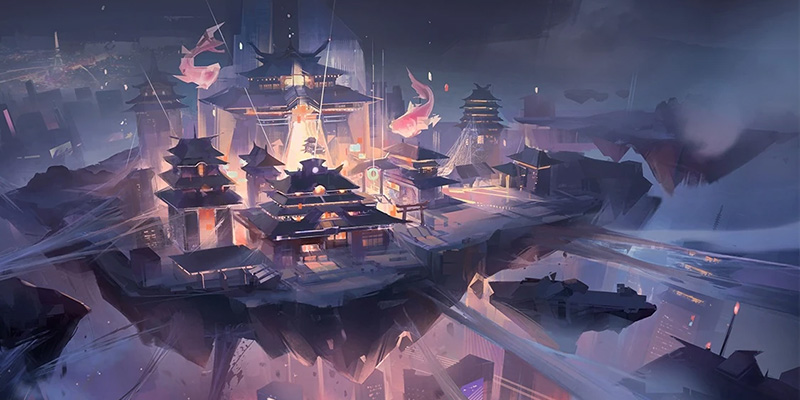Welcome to Neo-Tokyo! Your Edge in Marvel Rivals' 2099 Maps
Ready to conquer the dazzling, dangerous streets and skies of Tokyo 2099? This guide is your all-access pass to dominating the Shin-Shibuya and Spider-Islands maps in Marvel Rivals! These futuristic battlegrounds, steeped in Japanese aesthetics, present a unique blend of challenges and opportunities that demand smart hero selections tailored to their intricate designs. Shin-Shibuya, a Convergence map, is characterized by its "cyberpunk influence," featuring "many narrow alleyways with sneaky corners and vertical areas". In contrast, Spider-Islands, a Convoy map, throws players into an "interconnected web of platforms and narrow walkways" that test mobility and control. Moving beyond generic hero rankings, understanding how specific heroes excel within these environments is the key to victory; after all, "map awareness, adaptability, and skill are what win matches".

The "Tokyo 2099" setting provides a thematic link between two maps with distinct layouts and objectives, suggesting a design philosophy that rewards players who master a particular type of environmental awareness. Both Shin-Shibuya (Convergence mode: capture point then escort payload) and Spider-Islands (Convoy mode: escort payload from the start) emphasize verticality and complex pathing. This commonality implies that abilities like precise vertical aiming, swift repositioning using map geometry, and understanding multi-level sightlines are highly valuable across both. However, the application of these skills shifts with the game mode. For instance, leveraging verticality on Shin-Shibuya's initial capture point might be crucial for breaking a static defensive line, whereas on Spider-Islands, it translates to maintaining continuous pressure on a constantly moving payload. Players who grasp the underlying architectural philosophy of Tokyo 2099—how rooftops interconnect, where chokepoints naturally form, and how sightlines are established—will possess an advantage that transcends mere knowledge of specific routes.
Masters of Movement & Defense
Success in Tokyo 2099 often hinges on leveraging heroes with exceptional mobility or robust defensive capabilities. Three archetypes stand out: Grapplers, Flyers, and Shield-Bearers.
These heroes utilize grappling hooks or similar mechanics for rapid repositioning, executing devastating flanks, and sometimes initiating engagements. Prime examples include Spider-Man with his iconic Web-Swing, Moon Knight employing his Moonlight Hook, and Venom using the Venom Swing. Their general role involves launching surprise attacks, securing unconventional high-ground positions, and disrupting enemy formations. They thrive in environments rich with complex geometry, allowing them to "get the drop on enemies" or "cross distances easily".
Flyers are characterized by their ability to achieve sustained or significant aerial movement. This category includes heroes like Iron Man, who can fly automatically and use Hyper-Velocity for bursts of speed, Storm, also capable of automatic flight, Star-Lord with his Rocket Propulsion, and even the Vanguard Doctor Strange, who can take to the skies with his Cloak of Levitation. Their primary function is to dominate sightlines from above, provide aerial bombardment, and quickly traverse large open areas. Iron Man can effectively "scope out an arena," while Storm can "analyze the battlefield" from her aerial vantage point.
These heroes specialize in deploying personal or team-based energy shields and protective barriers. Notable shield-bearers are Doctor Strange, wielding the "largest shield in the game," the Shield of the Seraphim; Hulk, who can activate Indestructible Guard for himself and nearby allies; Captain America, using his iconic shield offensively and defensively with Living Legend; and the Strategist Invisible Woman, who deploys a Guardian Shield that also provides healing. Their role is to anchor pushes through chokepoints, protect teammates during objective captures or payload escorts, and mitigate incoming burst damage. Vanguards, by their nature, "lead the charge" and "shield teammates".
The prevalence of vertical elements and intricate pathing in the Tokyo 2099 maps inherently elevates the value of Grapplers and Flyers. This, in turn, makes Shield Heroes who can offer protection against multi-angle attacks more crucial for teams defending or attacking ground-based objectives. The maps' designs, rich in verticality and flanking routes, are naturally exploited by Grapplers and Flyers. Consequently, teams on the objective require shields capable of covering more than a single direction or providing mobile cover, such as those offered by Doctor Strange or Hulk. This interplay creates a dynamic tactical triangle: vertical attackers pressure objectives, shields counter this pressure, and mobile attackers attempt to bypass or overwhelm these defenses.
Shin-Shibuya Hero Guide
Shin-Shibuya is a Convergence map, meaning teams first battle to capture an initial objective, and then the successful attacking team must escort a payload—the "Spider"—to its destination. The map is a visual feast of "cyberpunk influence," characterized by "many narrow alleyways with sneaky corners and vertical areas," and even features destructible walls that can open new pathways. The flow of the map is divided into three distinct sections: "Capture the Spider," "Spider On The Streets," and "The Final Push".

Checkpoint 1: Capture the Spider
This initial phase focuses on securing the Spider payload. The routes to the objective are described as somewhat "strict," funneling teams towards a primary "corridor that passes under the suspended roof," creating a natural chokepoint. However, flanking options exist, including a path through the "ninja shop" which offers an elevated door or a destructible wall, and airborne routes accessible to certain heroes. Defenders often utilize various vantage points overlooking the objective area. The "destructible wall" within the ninja shop is a particularly interesting feature, as it allows for a dynamic entry point. Heroes with burst damage or specific abilities to breach it quickly can create an immediate flank, making defensive shield placement challenging.
Spider-Man's Web-Swing ability is exceptionally well-suited for this checkpoint. He can rapidly bypass the main chokepoint by utilizing the ninja shop's upper route or by swinging over buildings. This allows him to establish unexpected angles of attack, pick off defenders holding the objective, or disrupt their defensive setup.
While the initial pathways are somewhat enclosed, Iron Man's flight capabilities enable him to effectively gain high ground overlooking the objective or to quickly reposition once past the initial choke. His Repulsor Blasts can apply significant pressure to defenders from these elevated positions.
Doctor Strange's formidable Shield of the Seraphim is invaluable for orchestrating a push through the main corridor chokepoint. Its substantial size can protect multiple teammates, enabling them to secure a foothold on the objective. His Cloak of Levitation also provides a degree of personal mobility.
Checkpoint 2: Spider on the Streets (Payload Escort)
Once the Spider is captured, attackers must escort it through the city streets. This section features a mix of environments, including routes across rooftops and second floors, pathways through buildings at ground level, back alleys, and narrow streets. This phase involves more open areas interspersed with tight turns, demanding adaptability. The transition from the tighter initial capture point to these more varied streets means team composition might need to adjust.
Checkpoint 3: The Final Push (Payload Delivery)
The final phase involves escorting the payload to its ultimate destination, often into a more fortified or enclosed area. This section is notoriously difficult, partly because the defender spawn is very close to the objective, leading to relentless waves of defenders. Available routes include paths through what was formerly the defender's spawn, secluded passages, a bridge that passes over the objective, and a final room with limited entry points. The close proximity of the defender spawn means this phase often becomes a war of attrition.
| Checkpoint | Recommended Grappler | Recommended Flyer | Recommended Shield Hero |
|---|---|---|---|
| Capture the Spider | Spider-Man: Bypasses choke via Ninja Shop verticality/air routes | Iron Man: Utilizes aerial paths for high ground over objective | Doctor Strange: Pushes main corridor choke with large shield |
| Spider on the Streets | Moon Knight: Flanks effectively in mixed terrain using hook | Storm: Maintains aerial control over moving payload | Hulk: Provides mobile AoE shield for payload escort |
| The Final Push | Venom: Bypasses defenses into final room with swing/dive | Star-Lord: Uses burst flight for angles into final room | Captain America: Mobile shield for tight final pushes |
Spider-Islands Hero Guide
Spider-Islands presents a different challenge as a Convoy map, where one team must escort a payload from the very start to its final destination. The map is an "interconnected web of platforms and narrow walkways," where "mobility and control" are paramount. It features "lots of small buildings that you can get above" and sections with "open map area". A key characteristic is that "even though most of the map feels like a choke you can shoot and get shot from everywhere". The map progresses through three distinct zones: "The Attacking Spawn," "The Garden," and "Inside the Building".

Zone 1: The Breakout (Initial Payload Push from Attacker Spawn)
This zone covers the initial push of the payload from the attacker's starting area. There are multiple attacker spawn doors, each leading to different initial routes: an upper exit (Yellow path), a route through a side building (Red path), and the standard convoy path (Blue path). Some of these routes involve crossing an "open map area," which can be used as a shortcut. The multiple spawn exits mean attackers can immediately split pressure, making it difficult for defenders to establish a single, strong chokepoint at the outset.
Zone 2: The Garden Gauntlet (Mid-Map Payload Push)
The payload next moves through "The Garden," a more complex area featuring a bridge to pass under and, notably, a "pit of water" that can be used for environmental kills. This zone also offers an "under-utilized back path" (Green path) and various flanking routes towards its end (Yellow path). The "pit of water" is a significant environmental hazard and opportunity. Heroes possessing knockback abilities, like Invisible Woman's force push or even Hulk's powerful attacks, become extremely valuable here, not just for securing eliminations but also for area denial.
Zone 3: Inside the Building (Final Payload Push)
The payload's journey concludes by moving indoors towards the final delivery point. This zone is characterized by a "jump pad," an "elevated doorway" that leads directly to the finish line and the defender's spawn area. Additionally, there are "hidden paths," such as the Pink path which cuts under the main route, and multiple entry points to the final area. Defenders also have multiple routes from their spawn to contest the final push.
| Zone | Recommended Grappler | Recommended Flyer | Recommended Shield Hero |
|---|---|---|---|
| The Breakout | Spider-Man: Aggressive flanks from multiple spawn exits | Iron Man: Immediate aerial scouting & fire support | Doctor Strange: Secures initial payload push from spawn |
| The Garden Gauntlet | Moon Knight: Navigates varied terrain, exploits water pit | Storm: Controls open spaces, denies high ground | Invisible Woman: Mobile shield/heal, environmental kill potential |
| Inside the Building | Spider-Man: Exploits complex interior, hidden paths, jump pad | Star-Lord: Burst flight for indoor verticality, jump pad use | Magneto: Strong directional cover for final indoor push |
Tokyo's Top Tier Heroes
While many heroes can perform well, a few stand out for their consistent impact across both Tokyo 2099 maps, often because they combine their primary archetype strength with a degree of versatility or survivability that allows them to adapt to the multi-phase nature of Convoy and Convergence game modes.
"Spider-Man's unparalleled mobility makes him a constant threat. He can swing in quickly and bounce around, making him hard to hit."
The heroes highlighted demonstrate versatility; Spider-Man is not just mobile but also elusive. Iron Man combines flight with significant burst damage and good mobility options. Doctor Strange complements his massive shield with personal flight and offensive tools. This adaptability is crucial because objectives and map control points shift throughout a match, demanding heroes who can perform multiple roles effectively.
Quick Tips for Victory
Mastering the Tokyo 2099 maps requires more than just good aim; it demands sharp strategy and map knowledge.
- Always look up! Both Grapplers and Flyers will relentlessly exploit high ground
- Learn common sniper perches and aerial attack vectors on both maps
- Constantly check flanking routes like ninja shop and back alleys
- Use shields to create safe zones for pushers
- Ignoring vertical threats from Grapplers and Flyers
- Tunnel vision on the payload while ignoring space control
- Sticking with ineffective hero picks throughout entire match
- Not adapting strategy between different map phases
Ultimately, success in Marvel Rivals, especially on complex and dynamic maps like those found in Tokyo 2099, is often determined less by raw mechanical skill and more by superior game sense, deep map knowledge, and the ability to adapt—qualities this guide aims to foster. The ability to swap heroes mid-match is a core game mechanic that directly encourages and rewards such adaptability. By understanding the strengths of Grapplers, Flyers, and Shield-bearers in relation to specific map checkpoints and chokepoints, players can significantly increase their chances of achieving victory in the futuristic arenas of Tokyo 2099.
